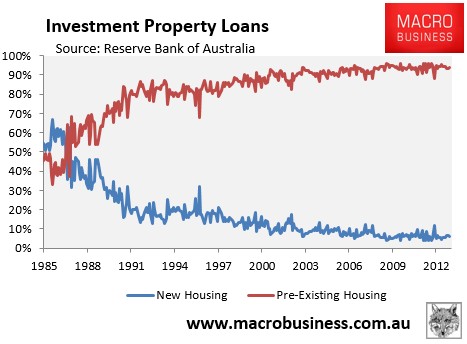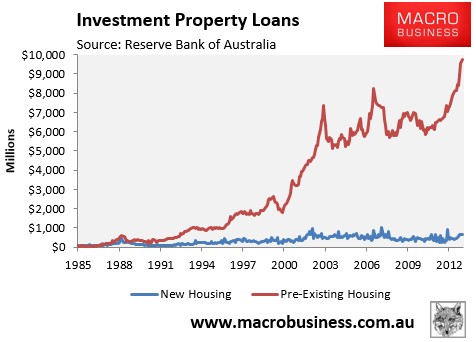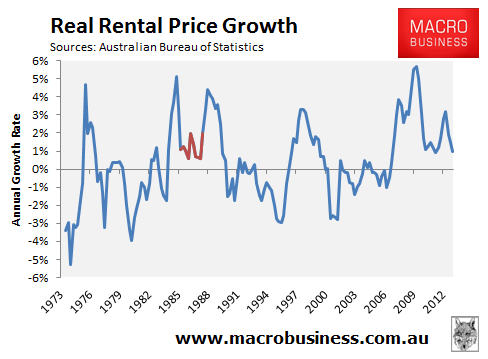
Over the year’s, we have heard a range of spurious arguments from housing interests on why negative gearing should be retained, despite its huge cost to the Budget and the upward pressure it places on house prices.
For example, we have heard that removing negative gearing would reduce the availability of rental properties and reduce the overall supply of housing. This is despite the data clearly showing that around 19 out of every 20 loans for investment properties are for pre-existing homes. As such, negative gearing is overwhelmingly turning homes for sale into homes for let and not improving the supply situation (see below charts).


We have also heard that abolishing negative gearing would lead to sharply rising rental costs, despite the data showing that when negative gearing was last “abolished” (i.e between June 1985 and September 1987), there was no discernible impact on rents, with periods of higher rental growth recorded both prior to and subsequently (see next chart).

Over the weekend, Domain’s Christina Zhou took a fresh angle, arguing that negative gearing is a positive remedy that allows first home buyers to enter the property market earlier than would otherwise be the case:
A new wave of Generation Y investors is entering the property market and many are using negative gearing as their way in.
ME Bank chief executive Jamie McPhee said high prices had forced many young buyers to enter the market as investors instead of owner-occupiers. ”What we’re seeing is that people who are buying an investment property are still living at home or renting with a group of people,” he said. ”When their financial situation improves when they’ve saved more, they can move into the home”…
A survey conducted by Mortgage Choice in 2013 also pointed to a new generation of home buyers using investments to enter the market.
The figures, based on about 340 Gen Ys surveyed nationally, found 40 per cent of them were looking for an investment property as their first purchase.
Century 21 Australia chairman Charles Tarbey said most people who used this strategy didn’t have a choice.
”They’re going to have to buy an investment property because they can’t buy what they want to live in [near] where they work,” he said.
”They’re just trying to get into the marketplace more than anything else.”
The fact that excessive demand from investors arising from negative gearing is pushing-up prices, locking-out would-be owner-occupied first home buyers (FHBs), is lost on the author. Instead, it is seen as a good thing that some FHBs are joining the negatively geared ranks, even though many simply do not have a choice as it’s the only way that they can enter the market.
The article also highlights how Australia’s housing system is no longer a system that rewards people for avoiding tax – it pretty much requires it. Join the housing ponzi or forever be damned!
Of course, any impartial analysis of negative gearing would conclude that it has long outgrown its usefulness. It should be wound back, with the Budget savings used instead to fund schools, hospitals, housing-related infrastructure, public housing, or any number of other worthwhile initiatives.

